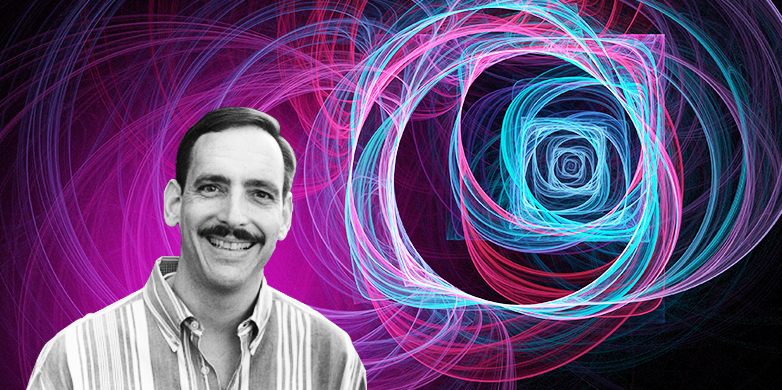Are there decisive answers to undecidable questions?
Unsolvable problems, the nature of the infinite and the question of whether and how mathematics can be definitively substantiated – these issues are the focus of the Bernays Lectures 2016. The speaker for this year’s honorary lectures at ETH Zurich is W. Hugh Woodin, Professor of Philosophy and Mathematics at Harvard University.

By its very nature, mathematics is a rigorous discipline that seeks and generates definitive, universally applicable truths. At the same time, the outer limits of mathematics still offer puzzles that defy definitive, consistent solutions. The paths that mathematicians take to reach solutions are to a large extent inspired by their imaginative powers and their philosophical position.
With the annual Paul Bernays Lectures, ETH Zurich offers a stage on which the philosophical aspects of the exact sciences can find expression. This year, logician and set theorist W. Hugh Woodin of Harvard University will be presenting his insights into unsolvable problems and the nature of the infinite.
As a researcher, Woodin engages with the foundations of mathematics and with the question of how mathematics as a whole can be logically structured and substantiated. Because any mathematical problem can be captured and represented in the form of sets, set theory is today considered the logical foundation of mathematics.
Infinities of various sizes
Like all mathematical theories, set theory is based on axioms. These are the simplest possible principles that are accepted as true, from which other true principles may consistently be derived, and that are together expected to form a whole (system) of the greatest possible completeness and consistency.
A standard system for natural numbers (0, 1, 2, 3, 4, 5, 6, etc.) established itself under the name ZFC, referring to Ernst Zermelo (1871–1953) and Abraham Fraenkel (1891–1965). Today, the ZFC axiom system encompasses nine axioms and is the foundation of set theory and thus of mathematics as a whole.
Woodin’s work addresses one of the greatest mysteries of set theory: the 'continuum hypothesis'. It was Georg Cantor (1845–1918), the founder of set theory, who first linked this hypothesis to the concept of the infinite.
In 1878, he discovered that the size of sets with an infinite number of elements could vary. For example, he proved that the set of real numbers (e.g. 7, −51, 106, 5/9, 2.4137, √3, π, etc.) that Richard Dedekind introduced into mathematics at ETH Zurich in 1858, was 'far more infinite' than the set of natural numbers. At the same time, he assumed that there could be no other infinity between these two infinities. However, he was unable to prove his conjecture, and developments in the 20th century have only served to intensify the issue.
Unsolvable problems – neither proven nor refuted
Kurt Gödel (1906–1978) initially proved that the continuum hypothesis was consistent with the ZFC axiom system. Then Paul Cohen (1934–2007) managed to prove that negation of the continuum hypothesis was also consistent with ZFC. The only conclusion to be drawn here is that the continuum hypothesis can neither be proven nor refuted by the axioms of set theory. The continuum hypothesis cannot be decided by ZFC and is therefore an unsolvable problem.
Both Gödel and Cohen developed techniques that could ultimately lead to a solution to the problem, and Woodin is one of those following in their footsteps, achieving intermediate successes with both techniques on the path to a definitive solution.
First, Woodin applied Cohen’s forcing technique, with which set theory models can be expanded to include certain basic statements and to generate or exclude sets with certain characteristics. In doing so, he sought to expand the ZFC axioms and to refute the continuum hypothesis. But more recently, Woodin has shifted to a model closer to Gödel’s 'constructible model L', which validates the continuum hypothesis. One model for ZFC here is a structure that fulfils all axioms of ZFC.
One true model, or a variety of models?
The opinions of set theorists differ sharply when it comes to the question of how to expand ZFC axioms. Some follow Woodin and hope to eventually find the 'right' set theory model by means of additional axioms. Others use the forcing method in an attempt to add or remove ZFC axioms, resulting in a multiplicity of set theory models.
Logician and set theorist Lorenz Halbeisen uses the forcing method. The ETH Zurich lecturer will provide an introduction to Woodin’s work at the Bernays Lecture on 14 September 2016. 'I’m fascinated by the richness of the ZFC axiom system and by the set theory models that can be created using it.'
Unlike Woodin, Lorenz Halbeisen is not searching for one ideal, ultimate model of set theory; he is more interested in 'how mathematics changes when you add or subtract an axiom and that it can thus maintain a variety of set theories or a variety of types of mathematics'.
But Halbeisen admits that for researchers like Woodin, who view set theory as the foundation of mathematics, there is little sense in having different models of mathematics, 'because that would also mean that the whole of mathematics is arbitrary to a certain extent,' says Halbeisen. 'For people like me, though, who see set theory as a branch of mathematics, that is precisely what’s so exciting, that you can compare different models and explore the limits of an axiomatic system.”
Paul Bernays Lectures 2016
Prof. W. Hugh Woodin, Harvard University, USA
Lecture 1:
UNSOLVABLE PROBLEMS, THE CONTINUMM HYPOTHESIS, AND THE NATURE OF INFINITY
Wednesday, September 14, 2016, 17.00 h, Auditorium F 3, ETH Main Building
Lecture 2:
UNSOLVABLE PROBLEMS IN SECOND ORDER NUMBER THEORY AND THEIR SOLUTIONS
Thursday, September 15, 2016, 14.15 h, Auditorium F 3, ETH Main Building
Lecture 3:
BEYOND THE AGE OF INDEPENDENCE BY FORCING
Thursday, September 15, 2016, 16.30 h, Auditorium F 3, ETH Main Building

